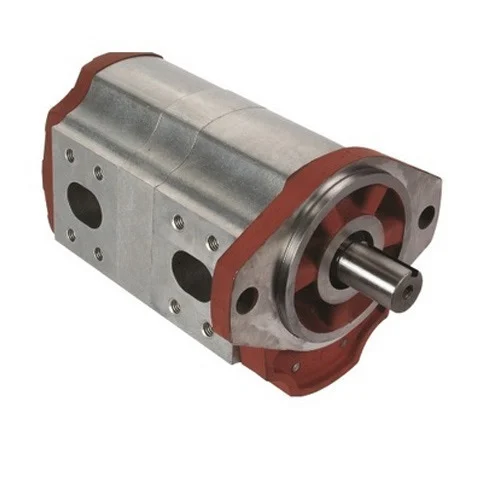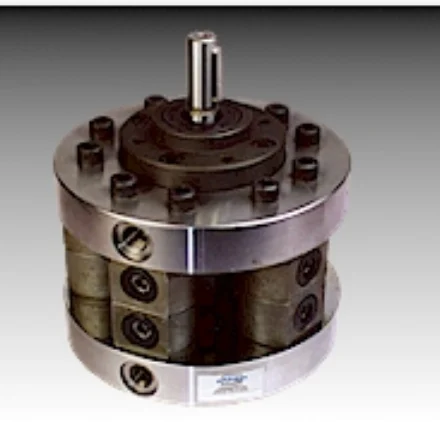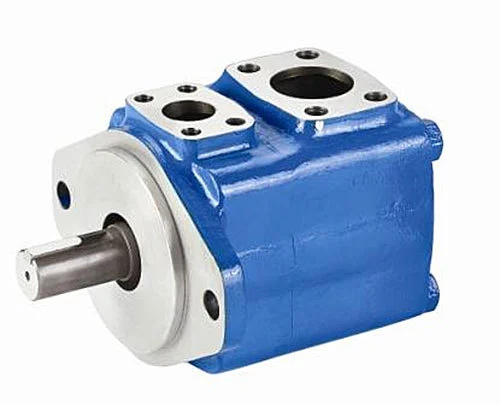Contact : +91-79045 61980 | Email: hydrofitengineers@gmail.com
HYDRAULIC PUMPS
There are four types of Hydraulic Pumps
Hydraulic pumps are vital components in hydraulic systems, converting mechanical energy into hydraulic energy by generating fluid flow. This fluid flow is then used to transmit power in various industrial and mobile applications. Different types of hydraulic pumps are designed to meet specific requirements, each with unique operating principles and advantages. This article explores the primary types of hydraulic pumps: vane pumps, gear pumps, radial piston pumps, and axial piston pumps.
Hydraulic Vane Pumps
Operating Principle: Vane pumps operate by using vanes mounted on a rotor. The rotor rotates within a cavity, and the vanes slide in and out, sealing against the pump housing. As the rotor turns, the volume between the vanes changes, drawing hydraulic fluid into the pump and then pushing it out into the system.
Applications: Vane pumps are commonly used in mobile equipment, industrial machinery, automotive applications, and power steering systems. They are particularly favored in applications where noise reduction is critical.
Advantages:
- Efficiency: Vane pumps are highly efficient at low to moderate pressures, making them ideal for many industrial applications.
- Quiet Operation: They are known for their quiet operation compared to other pump types.
- Versatility: Vane pumps can handle a wide range of fluid viscosities, making them versatile in various environments.
Hydraulic Gear Pump
Operating Principle: Gear pumps are one of the most straightforward types of hydraulic pumps. They consist of two gears (a driving gear and a driven gear) that mesh together. As the gears rotate, they create a vacuum at the pump inlet, drawing hydraulic fluid in and then pushing it out through the outlet as the gears mesh together.
Types of Gear Pumps:
- External Gear Pumps: Both gears are external and work together to move the fluid.
- Internal Gear Pumps: One gear is inside the other, allowing for more compact designs.
Advantages:
- Durability: Gear pumps are robust and can handle high pressures.
- Cost-Effectiveness: They are generally less expensive to manufacture and maintain.
Simplicity: The design is straightforward, making them easy to service and repair
Applications: Gear pumps are widely used in hydraulic systems, including construction equipment, agricultural machinery, and industrial hydraulic systems. They are particularly effective in systems requiring constant fluid flow and high pressure
Radial Piston Pumps
Operating Principle: Radial piston pumps feature pistons arranged radially around a central drive shaft. As the shaft rotates, it pushes the pistons in and out of cylinders. This movement creates pressure, which forces the hydraulic fluid to flow through the system.
Advantages:
- High Pressure Capabilities: Radial piston pumps can operate at very high pressures, making them suitable for demanding applications.
- Efficiency: They offer high volumetric efficiency, meaning they can handle high loads with minimal energy loss.
- Compact Design: Despite their high power output, radial piston pumps are often compact.
Applications: Radial piston pumps are typically used in heavy-duty applications, such as industrial presses, injection molding machines, and large construction machinery. Their ability to handle high pressures makes them ideal for applications requiring precise control and high force.
Axial Piston Pumps
Operating Principle: Axial piston pumps operate with pistons arranged parallel to the drive shaft. The pistons move in and out of the cylinders as the drive shaft rotates, creating a flow of hydraulic fluid. The angle of the swashplate determines the stroke of the pistons, allowing for variable displacement.
Advantages:
- Variable Displacement: Axial piston pumps offer adjustable flow rates, making them highly adaptable to different system requirements.
- High Efficiency: They provide excellent efficiency across a wide range of operating conditions.
- Durability: These pumps are designed for long service life, even in demanding applications.
Applications: Axial piston pumps are commonly used in mobile equipment, such as excavators and forklifts, as well as industrial applications requiring precise control over fluid flow. Their ability to adjust displacement makes them ideal for systems where varying flow rates are necessary.
Understanding the different types of hydraulic pumps is crucial for selecting the right pump for your specific application. Vane pumps offer quiet operation and versatility, gear pumps provide simplicity and durability, radial piston pumps excel in high-pressure environments, and axial piston pumps offer variable displacement and high efficiency. Each type has its unique strengths, making them suitable for a wide range of applications in various industries.
When selecting a hydraulic pump, consider the specific requirements of your system, including pressure, flow rate, fluid type, and environmental conditions. By choosing the right pump, you can ensure optimal performance, efficiency, and longevity in your hydraulic system.
Lorem ipsum dolor sit amet, consectetur adipiscing elit. Ut elit tellus, luctus nec ullamcorper mattis, pulvinar dapibus leo.
Eaton hydraulic pumps




